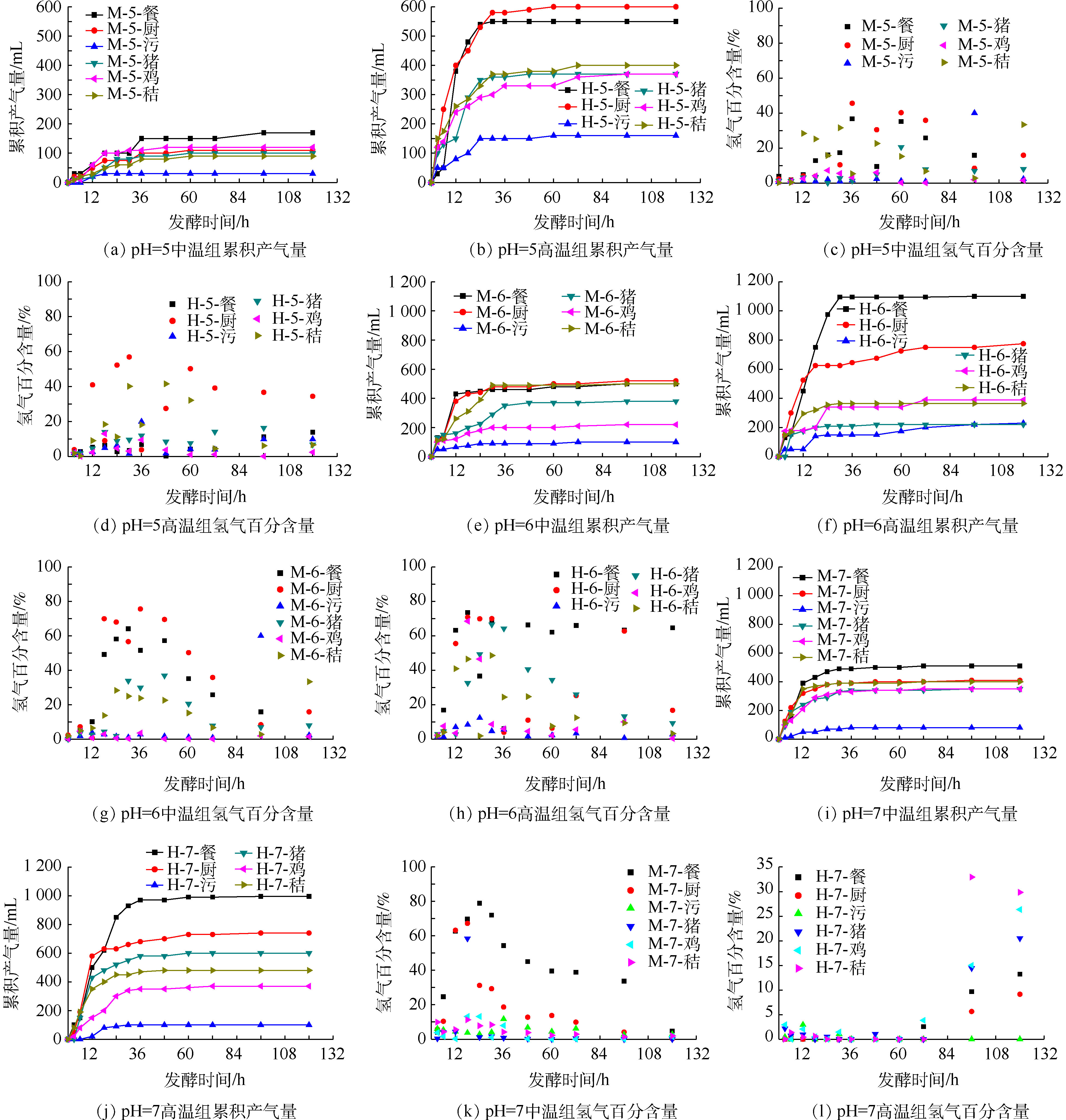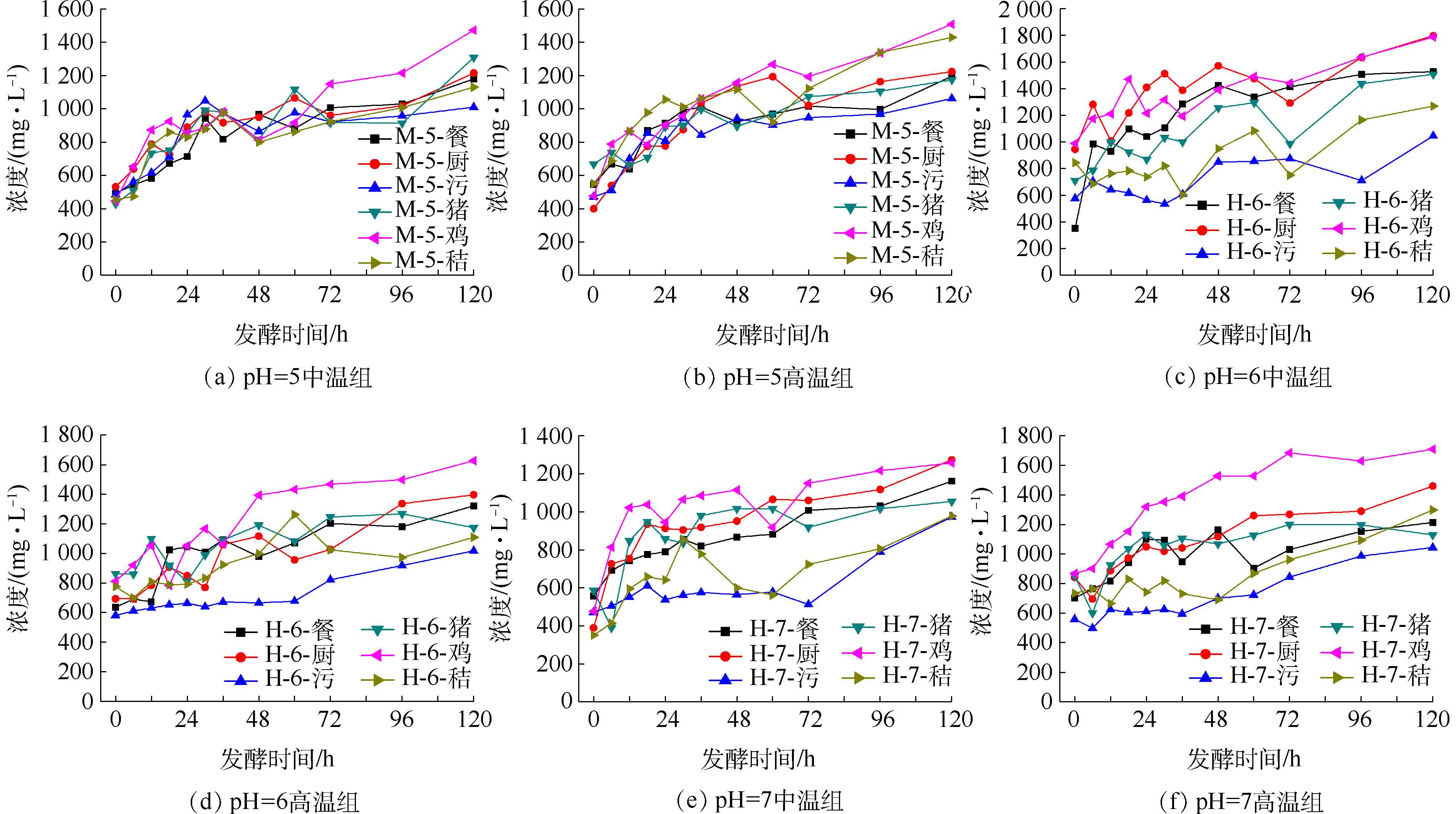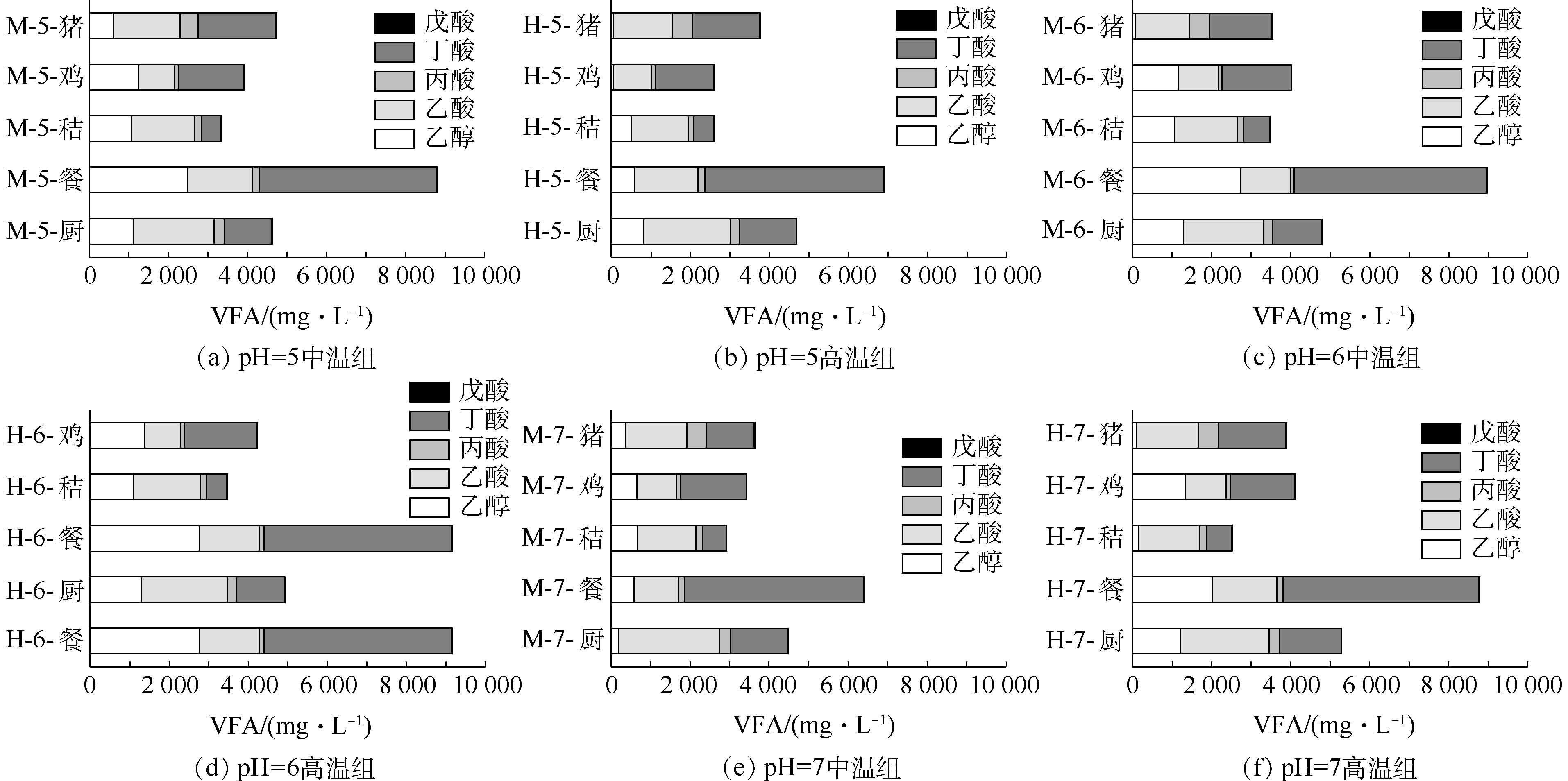-
我国农业固体废物年产量高达4×1010 t,“垃圾乱倒、秸秆焚烧、柴草乱跺、粪土乱堆、畜禽乱跑”等现象造成严重的农业面源污染和资源浪费[1]。农业固体废物是重要的生物质资源,富含有机质、氮、磷等营养物质,其能源化利用是未来我国新能源领域的突破点[2-4]。氢能被认为是未来最重要的清洁能源之一,具有能量密度高、热效率高、绿色清洁等特点[5]。暗发酵产氢是在传统厌氧生物处理基础上发展起来的绿色能源制备技术,具有微生物比产氢速率高、不受光照限制、工艺简单和可利用有机物范围广等优势,是农业固体废物能源化利用的理想途径[6-8]。如何提高农业固体废物的暗发酵产氢效率,保证产氢系统高效稳定运行一直是制氢领域的研究热点。
近年来的研究发现,温度、pH是影响暗发酵产氢效率和系统稳定性的重要非生物性因素。张彤[9]研究了pH对常见农业固体废弃物厌氧发酵的影响,发现不同初始pH会显著影响厌氧发酵启动时间。卢怡等[10]研究了农业固体废物厌氧产氢的潜力,以乳酸调控系统pH为4.7~5.5,发现控制体系温度在(25±1) ℃时可以产生氢气。MA等[11]研究了温度对污泥暗发酵的影响,认为最适发酵温度为55 ℃左右。陈智远等[12]研究了不同温度对畜禽粪便厌氧发酵的影响,发现相比25 ℃,粪便在35 ℃条件下厌氧发酵具有明显优势。LI等[13]以加热预处理后的餐厨垃圾为底物进行暗发酵产氢,研究发现,系统pH从4.36升高至5.81,氢浓度升高到26.6%。目前,国内外围绕有机固体废物暗发酵产氢影响因素的研究已有报道,但以典型农业固体废物为研究对象,阐明非生物性因素对不同农业固体废物暗发酵产氢性能和代谢途径影响的研究鲜有报道。
根据农业固体废物的组成与特性,本研究选取畜禽粪便、秸秆、生活垃圾等多种典型农业固体废物为底物,探究温度、初始pH等非生物性因素对暗发酵产氢性能、代谢产物、产氢代谢途径的影响,采用Gompertz模型对暗发酵产氢系统启动时间、最大产氢速率和产氢潜力进行动力学解析,为解决暗发酵产氢的反馈抑制作用,有效提高农业固体废物的氢能源转化效率提供参考。
-
猪粪、鸡粪、玉米秸秆、餐厨垃圾和厨余垃圾取自北京市顺义区某农场,去除猪粪、鸡粪中的大块杂质;餐厨垃圾和厨余垃圾去除骨头、纸巾、筷子等杂物,破碎至粒径5 mm以下;玉米秸秆破碎后过200目筛。上述实验样品分别保存至4 ℃冰箱,备用。接种污泥取自猪粪厌氧发酵后的剩余沼渣,过筛去除大块杂质,保存于4 ℃箱中备用。原料和接种污泥的基本理化指标如表1所示。
-
实验采用500 mL发酵瓶,20 g猪粪、鸡粪、玉米秸秆、餐厨垃圾、厨余垃圾与接种污泥(以VS计)按照1∶1比例进行混合,使用去离子水将其定容至200 mL。采用1 mol·L−1 HCl与1 mol·L−1 NaOH,调节初始pH分别至5.0、6.0和7.0。向发酵瓶中通高纯氮气5 min,排除空气,分别在(35±1 ) ℃(中温)、(55±1 ) ℃(高温),转速120 r·min−1条件下进行暗发酵产氢,用排水集气法收集产气,同时做平行实验。在暗发酵产氢初期(0~48 h),每隔3 h采集样品,之后每隔6 h采集样品。
-
采用修正的Gompertz方程[14]对暗发酵产氢的动力学进行分析。挥发性固体(VS)、总固体(TS)、含水率、pH采用国标法[15-17]测定;氨氮采用纳氏试剂分光光度法[18]测定。
气体体积分数(H2,CH4和CO2)、乙醇和挥发性脂肪酸(VFA)含量均采用气相色谱仪(GC-7900,上海天美科学仪器有限公司公司)测定。气体体积分数测定的色谱条件:分析柱为2 m hayesep Q,柱温80 ℃,进样口温度120 ℃,检测器温度120 ℃,电流50 mV,载气为高纯氩气,进样量1 mL。以峰面积定量,校正归一法计算气体含量。乙醇和VFA测定的色谱条件:分析柱为5A分子筛3 m,柱温80 ℃,进样口温度250 ℃,检测器温度250 ℃,载气为高纯氩气,进样量1 µL。
-
在不同温度和初始pH条件下,累积产气量和氢气百分含量随时间的变化情况如图1所示。结果表明,不同温度和初始pH对暗发酵产氢有显著影响,除在初始pH为6.0时的鸡粪和玉米秸秆实验组,同一物料中高温组累积产气量均高于中温组,并于12 h时达最大值。初始pH为5.0时,其中高温组厨余垃圾累积产气量和氢气百分含量最大,分别为600 mL和56.95%,是中温组的5.45倍和1.25倍。中温组餐厨垃圾累积产气量最高,为170 mL,其次为鸡粪(120 mL)、厨余垃圾(110 mL);厨余垃圾中氢气百分含量最高,为45.62%,其次为餐厨垃圾(36.75%)。初始pH为6.0时,高温组餐厨垃圾累积产气量和氢气百分含量最大,分别为1 100 mL和73.58%,是中温组的2.2倍和1.36倍;中温组厨余垃圾累积产气量最多,为520 mL,其次为餐厨垃圾(500 mL)、玉米秸秆(500 mL);厨余垃圾氢气百分含量最高,为69.54%,其次为餐厨垃圾(64.12%)。初始pH为7.0时,高温组餐厨垃圾累积产气量和氢气百分含量最大,分别为995 mL和57.49%,是中温组的1.95倍和0.73倍。中温组餐厨垃圾累积产气量和氢气百分含量最高,分别为510 mL和78.87%,其次为厨余垃圾(410 mL,63.19%)。
郭欧燕等[19]以餐厨垃圾为底物,在不同温度下进行厌氧发酵,发现发酵温度与累积产气量具有相关性。袁雨珍等[20]以蒸煮餐厨垃圾为发酵底物进行研究,发现在初始pH为9.0时,厌氧发酵效果最佳,累积产气量和产氢量最大。宋梓梅[21]研究了鸡粪和果蔬废弃物混合发酵生物制氢,发现升高pH会降低氢气浓度,最大氢气浓度出现时间也会相应延迟。随着初始pH的升高,累积产气量大体呈现先上升后下降的趋势。总之,在55 ℃高温,初始pH为6.0的条件下,农业固体废物可以获得最佳的产气效果,其中,餐厨垃圾累积产气量和氢气含量最佳。因此,初始pH对微生物暗发酵影响较大,过高或过低的pH可能不利于微生物的生长与繁殖,从而导致厌氧发酵产氢效率降低。
-
为了揭示不同类型底物的暗发酵产氢动力学原理,采用修正的Gompertz模型对累积产氢量进行了动力学拟合。最大产氢潜力、最大产氢速率和延迟时间的变化趋势如图2和表2所示。不同温度、pH条件下的5种农业固体废物的拟合度R2都在0.95以上。结果表明,不同初始pH条件下,高温组的最大产氢速率与产氢潜力均优于中温组。初始pH为5.0,高温组厨余垃圾产氢速率和产氢潜力最大,分别为8.45 mL·h−1和151.45 mL。初始pH为6.0时,高温组餐厨垃圾产氢速率和产氢潜力最大,分别为37.11 mL·h−1和660.30 mL。初始pH为7.0时,高温组餐厨垃圾产氢潜力最大(370.44 mL),厨余垃圾产氢速率最大(31.47 mL·h−1)。由此可见,餐厨垃圾实验组在55 ℃高温、初始pH为6.0时,具有最大产氢潜力,产氢速率最佳,启动速度较快,完成发酵周期用时较短。
-
在不同温度、初始pH条件下,农业固体废物产氢过程pH和氨氮的变化趋势如图3和图4所示。可以看出,在不同初始pH条件下,由于有机物降解速率加快,导致初期产氢pH呈先升高后降低的趋势。初始pH为5.0的高温组餐厨垃圾pH于18 h时最小,为4.51;中温组厨余垃圾pH于18 h时最小,为4.36。随着暗发酵产氢过程的进行,pH均稳步上升,保持在5.0~6.6。初始pH为6.0的高温组餐厨垃圾pH于48 h时最小,为5.83;中温组厨余垃圾pH于60 h时最小,为5.34。随着暗发酵产氢过程的进行,pH均波动上升,保持在6.0~7.4。初始pH为7.0的高温组厨余垃圾pH于60 h时最小,为5.4;中温组厨余垃圾pH于18 h时最小,为5.91。随着暗发酵产氢过程的进行,pH均波动上升,保持在6.0~7.4。氨氮含量在暗发酵产氢过程中呈上升趋势,不同初始pH和温度对氨氮含量影响较小。其中,鸡粪实验组氨氮含量在120 h时达最大值,在1 256.85~1 788.17 mg·L−1。氨氮是暗发酵微生物的营养物质,在反应过程中能中和暗发酵产生的VFA,对系统的pH具有缓冲作用,但若其浓度过高,则会抑制微生物活性[22]。微生物对pH的波动十分敏感,低于最适pH下限并持续过久时,会导致产甲烷菌失活而产乙酸菌大量繁殖,引起反应的“酸化”[23]。由此可见,5种农业固体废物暗发酵产氢过程未发生酸化反馈抑制作用,但鸡粪产氢产生了氨氮抑制,产氢效果差。
-
农业固体废物暗发酵产氢高峰期(12 h)、发酵末期(120 h)代谢产物中乙醇和VFA含量如图5和图6所示。根据乙醇和VFA组成,可将暗发酵产氢途径分为乙醇型发酵、丁酸型发酵、丙酸型发酵和混合酸发酵[24]。随着5种农业固体废物的水解酸化,产氢高峰期的pH迅速下降,产生大量VFA和乙醇,随着微生物对中间代谢产物的利用,发酵末期代谢产物浓度呈下降趋势。初始pH为5.0时,高温组餐厨垃圾、猪粪、鸡粪中丁酸浓度最大,分别为4 536.56、1 695.23和1 469.32 mg·L−1,占总VFA的65.64% 、44.9%和56.44%;中温组餐厨垃圾、猪粪、鸡粪中丁酸浓度最大,分别为4 489.06、1 962.05和1 650.15 mg·L−1,占总VFA的51.05% 、41.46%和42.12%。中温组餐厨垃圾乙醇浓度最高为2 492.45 mg·L−1。
初始pH为6.0时,高温组,餐厨垃圾、猪粪、鸡粪中丁酸浓度最大,分别为4 756.90、1 689.27和1 840.14 mg·L−1,占总VFA的51.93% 、38.59%和43.51%;中温组餐厨垃圾、猪粪、鸡粪中丁酸浓度最大,分别为4 862.56、1 563.23和1 765.16 mg·L−1,占总VFA的54.20%、44.08%和43.80%。高温组和中温组餐厨垃圾乙醇浓度最高,分别为2 766.99 mg·L−1和2 732.67 mg·L−1,占总VFA的30%左右。
初始pH为7.0时,高温组,餐厨垃圾、猪粪和鸡粪中丁酸浓度最大,分别为4 536.53、1 208.52和1 658.52 mg·L−1,占总VFA的70.72% 、33.14%和48.28%;中温组餐厨垃圾、猪粪和鸡粪中丁酸浓度最大,分别为4 536.53、1 208.52和1 658.52 mg·L−1,占总VFA的70.72%、33.13%和48.28%。高温组餐厨垃圾乙醇浓度最高为2 022.02 mg·L−1,占总VFA的23.02%。中温组玉米秸秆乙醇浓度最高为655.87 mg·L−1,占总VFA的22.41%。
综上所述,在不同初始pH和温度条件下,餐厨垃圾产氢代谢产生的丁酸浓度均最高,其次为猪粪、鸡粪;餐厨垃圾实验组乙醇含量最高,还含有乙酸、丙酸和丁酸等多种代谢产物;5类农业固体废物产氢代谢途径均为以丁酸型发酵为主的混合型发酵。NAGAO等[25]以餐厨垃圾为原料进行单相厌氧连续发酵发现,VFA总浓度低于5 000 mg·L−1时,其主要成分为乙酸和丁酸;VFA总浓度超过5 000 mg·L−1时,其成分中丁酸所占比例最高。
-
1)不同温度和初始pH对暗发酵产氢性能有明显影响,高温组累积产气量和氢气百分含量显著高于中温组,随着初始pH的升高,累积产气量均呈先上升后下降的趋势。在初始pH为7.0时,餐厨垃圾累积产气量和氢气百分含量高于其他农业固体废物。
2)通过修正的Gompertz模型评价暗发酵系统产氢潜力,在55 ℃高温、初始pH为6.0时,餐厨垃圾的暗发酵产氢速率和产氢潜力最大,分别为37.11 mL·h−1和660.30 mL。鸡粪暗发酵的产氢启动时间最短为0.5 h,但产氢末期氨氮浓度最高,产氢潜力低。
3)根据乙醇和VFA组成含量分析可知,猪粪、鸡粪、玉米秸秆、餐厨垃圾和厨余垃圾暗发酵产氢均是以丁酸型发酵为主的混合型发酵。其中餐厨垃圾在不同初始pH和温度条件下产氢代谢产生的丁酸浓度最高。
温度和初始pH对农业固体废物暗发酵产氢的影响
Effects of temperature and initial pH on the hydrogen production by dark fermentation of agricultural solid waste
-
摘要: 以猪粪、鸡粪、玉米秸秆、餐厨垃圾和厨余垃圾等5种农业固体废物为底物,采用修正的Gompertz模型,研究了典型农业固体废物暗发酵产氢动力学和代谢产物变化规律,探讨了不同温度和初始pH条件下的主要产氢代谢途径。结果表明:温度和初始pH对农业固体废物暗发酵产氢具有显著影响;高温组累积产气量和氢气百分含量显著高于中温组。在55 ℃高温且pH为6.0的条件下,餐厨垃圾暗发酵产氢效果最佳,累积产气量和氢气百分含量最大,为1 100 mL和73.58%,最大产氢速率和产氢潜力分别为37.11 mL·h−1和660.30 mL;厨余垃圾暗发酵产氢效果次之,鸡粪产氢潜力最差。在暗发酵产氢末期,以鸡粪为底物的代谢产物的氨氮浓度最高,过高的氨氮浓度可能抑制了产氢过程。VFA分析表明:不同底物和条件下丁酸浓度均最高,且含有少量乙醇、乙酸、丙酸等;暗发酵产氢代谢途径是以丁酸型发酵为主的混合型发酵。通过温度、初始pH等非生物性控制因素的优化调控,显著提高了农业固体废物暗发酵产氢潜力和底物利用效率,为生物制氢的技术研发与工程应用提供参考。Abstract: In this study, five kinds of typical agricultural solid wastes including pig feces, chicken feces, corn stover, food waste and kitchen waste were taken as substrates, and the effects of temperature and initial pH on their hydrogen production potential by dark fermentation were determined by using the modified Gompertz model, and the main pathways of hydrogen production and metabolism were analyzed. The results showed that temperature and initial pH had significant effects on the hydrogen production by dark fermentation of agricultural solid wastes. The cumulative gas production and hydrogen content in high temperature group were significantly higher than those in medium temperature group. At high temperature of 55 ℃ and pH 6.0, the best dark fermentation effect of food wastes was achieved, and the highest cumulative gas production and hydrogen content were obtained with respective value of 1 100 mL and 73.58%, and the maximum hydrogen production rate and hydrogen production potential were 37.11 mL·h−1 and 660.30 mL, which were followed by kitchen waste, while chicken feces had the worst hydrogen production potential. The concentration of ammonia nitrogen was the highest at the end of hydrogen production by dark fermentation of chicken feces. Excessive concentration of ammonia nitrogen might inhibit the hydrogen production process. VFA analysis showed that the concentration of butyric acid was the highest under different substrates and conditions, and it also contained a small amount of ethanol, acetic acid, propionic acid. The hydrogen production pathway was a mixed fermentation based on butyric acid fermentation. Through optimizing and controlling the non-biological control factors such as temperature and initial pH, the potential of hydrogen production by dark fermentation of agricultural solid wastes and the utilization efficiency of biomass were significantly improved, which provided a theoretical basis for the research and development of biological hydrogen production technology and engineering application.
-
Key words:
- agricultural solid waste /
- dark fermentation /
- pH /
- temperature /
- metabolites /
- dynamic analysis
-
表 1 农业固体废物的基本指标
Table 1. Basic characteristics of agricultural solid waste
实验样品 含水率/% TS/(g·L−1) VS/(g·L−1) 灰分/(g·L−1) pH C/N 猪粪 75.13 248.68 198.65 50.03 7.52 12.66 鸡粪 64.55 354.51 173.80 180.71 7.49 8.47 玉米秸秆 8.45 915.51 845.38 70.13 5.24 47.48 餐厨垃圾 81.55 184.47 172.23 11.25 6.34 13.31 厨余垃圾 93.32 66.79 59.45 7.34 6.29 20.00 接种污泥 80.82 191.77 94.47 97.30 8.59 10.21 注:TS为总固体;VS为挥发性固体。 表 2 产氢动力学分析
Table 2. Hydrogen kinetics analysis
处理条件 实验样品 Pmax/mL Rmax/(mL·h−1) λ/h R2 35 ℃中温,初始pH=5.0 猪粪 3.92 0.11 4.67 0.950 35 ℃中温,初始pH=5.0 鸡粪 3.29 0.21 6.13 0.961 35 ℃中温,初始pH=5.0 玉米秸秆 11.51 0.71 6.49 0.994 35 ℃中温,初始pH=5.0 餐厨垃圾 28.89 1.54 13.11 0.955 35 ℃中温,初始pH=5.0 厨余垃圾 24.89 3.62 29.56 0.976 35 ℃中温,初始pH=5.0 接种污泥 0.35 0.09 10.66 1 55 ℃高温,初始pH=5.0 猪粪 28.79 3.53 11.72 0.997 55 ℃高温,初始pH=5.0 鸡粪 12.73 0.63 0.50 0.992 55 ℃高温,初始pH=5.0 玉米秸秆 42.07 1.90 5.59 0.994 55 ℃高温,初始pH=5.0 餐厨垃圾 27.10 3.20 6.39 0.999 55 ℃高温,初始pH=5.0 厨余垃圾 151.55 8.45 6.07 0.969 55 ℃高温,初始pH=5.0 接种污泥 6.67 0.38 2.83 0.971 35 ℃中温,初始pH=6.0 猪粪 51.12 4.01 24.12 0.998 35 ℃中温,初始pH=6.0 鸡粪 2.16 0.14 3.15 0.995 35 ℃中温,初始pH=6.0 玉米秸秆 62.24 4.29 12.92 0.984 35 ℃中温,初始pH=6.0 餐厨垃圾 53.44 3.61 3.61 0.999 35 ℃中温,初始pH=6.0 厨余垃圾 79.49 5.05 9.94 0.996 35 ℃中温,初始pH=6.0 接种污泥 1.55 0.11 1.22 0.997 55 ℃高温,初始pH=6.0 猪粪 40.39 4.48 10.42 0.999 55 ℃高温,初始pH=6.0 鸡粪 84.60 16.19 17.26 0.995 55 ℃高温,初始pH=6.0 玉米秸秆 67.59 9.29 5.80 0.999 55 ℃高温,初始pH=6.0 餐厨垃圾 660.30 37.11 7.66 0.996 55 ℃高温,初始pH=6.0 厨余垃圾 228.17 24.00 6.93 0.995 55 ℃高温,初始pH=6.0 接种污泥 10.16 1.39 11.89 0.999 35 ℃中温,初始pH=7.0 猪粪 30.54 5.59 11.20 0.988 35 ℃中温,初始pH=7.0 鸡粪 18.30 1.27 2.56 0.998 35 ℃中温,初始pH=7.0 玉米秸秆 27.35 2.98 0.43 0.981 35 ℃中温,初始pH=7.0 餐厨垃圾 237.37 22.38 4.97 0.999 35 ℃中温,初始pH=7.0 厨余垃圾 113.49 10.46 4.17 0.997 35 ℃中温,初始pH=7.0 接种污泥 4.23 0.18 0.58 0.979 55 ℃高温,初始pH=7.0 猪粪 130.53 13.33 5.03 0.990 55 ℃高温,初始pH=7.0 鸡粪 24.03 1.49 2.59 0.996 55 ℃高温,初始pH=7.0 玉米秸秆 133.97 9.49 2.96 0.997 55 ℃高温,初始pH=7.0 餐厨垃圾 370.44 20.21 7.18 0.992 55 ℃高温,初始pH=7.0 厨余垃圾 300.31 31.47 3.23 0.999 55 ℃高温,初始pH=7.0 接种污泥 48.72 11.03 12.30 0.999 -
[1] 陶干. 湖南省农作物秸秆资源能源化利用潜力评价[D]. 长沙: 湖南农业大学, 2016. [2] 韩成英. 农户感知价值对其农业废弃物资源化行为的影响研究[D]. 武汉: 华中农业大学, 2016. [3] 孙永明, 李国学, 张夫道, 等. 中国农业废弃物资源化现状与发展战略[J]. 农业工程学报, 2005, 21(8): 169-173. doi: 10.3321/j.issn:1002-6819.2005.08.037 [4] 侯亚丹. 湖北农作物秸秆资源量化及其利用模式研究[D]. 武汉: 华中师范大学, 2017. [5] 毛宗强. 氢能: 我国未来的清洁能源[J]. 太阳能学报, 2005, 26(3): 6-8. [6] 张国华, 张志红, 黄江丽, 等. 餐厨垃圾厌氧发酵制氢残留物连续沼气发酵研究[J]. 江西科学, 2015, 33(5): 721-724. [7] HECHT C, GRIEHL C. Investigation of the accumulation of aromatic compounds during biogas production from kitchen waste[J]. Bioresource Technology, 2009, 100(2): 654-658. doi: 10.1016/j.biortech.2008.07.034 [8] MIN K, KHAN A, KWON M, et al. Acidogenic fermentation of blended food-waste in combination with primary sludge for the production of volatile fatty acids[J]. Journal of Chemical Technology & Biotechnology , 2010, 80(8): 909-915. [9] 张彤. 温度和pH值调控对厌氧发酵产甲烷影响的研究[D]. 杨凌: 西北农林科技大学, 2017. [10] 卢怡, 张无敌, 宋洪川, 等. 农业固体废弃物发酵产氢的研究[J]. 环境科学与技术, 2009, 32(9): 60-63. doi: 10.3969/j.issn.1003-6504.2009.09.015 [11] MA D L R, RIAU V, RAPOSO F, et al. Thermophilic anaerobic digestion of sewage sludge: Focus on the influence of the start-up: A review[J]. Critical Reviews in Biotechnology, 2013, 33(4): 448-460. doi: 10.3109/07388551.2012.726962 [12] 陈智远, 蔡昌达, 石东伟. 不同温度对畜禽粪便厌氧发酵的影响[J]. 贵州农业科学, 2009, 37(12): 148-151. doi: 10.3969/j.issn.1001-3601.2009.12.045 [13] LI M, ZHAO Y, GUO Q, et al. Bio-hydrogen production from food waste and sewage sludge in the presence of aged refuse excavated from refuse landfill[J]. Renewable Energy, 2008, 33(12): 2573-2579. doi: 10.1016/j.renene.2008.02.018 [14] CHEN W H, CHEN S Y, KHANAL S K, et al. Kinetic study of biological hydrogen production by anaerobic fermentation[J]. International Journal of Hydrogen Energy, 2006, 31(15): 2170-2178. doi: 10.1016/j.ijhydene.2006.02.020 [15] 中华人民共和国国家质量监督检验检疫总局, 中国国家标准化管理委员会. 饲料中水分和其他挥发性物质含量的测定: GB/T 6435-2006[S] 北京: 中国标准出版社, 2006. [16] 中华人民共和国国家质量监督检验检疫总局, 中国国家标准化管理委员会. 饲料中粗灰分的测定: GB/T 6438-2007[S]. 北京: 中国标准出版社, 2007. [17] 国家环境保护局. 水质pH值的测定 玻璃电极法: GB/T 6920-1986[S]. 北京: 中国标准出版社, 1987. [18] 崔家荣. 水中氨氮纳氏试剂分光光度法测定[J]. 现代农业科技, 2008(8): 208-209. doi: 10.3969/j.issn.1007-5739.2008.08.145 [19] 郭欧燕, 李轶冰, 白洁瑞, 等. 温度对鸡粪与秸秆混合原料厌氧发酵产气特性的影响[J]. 西北农林科技大学学报(自然科学版), 2009, 37(6): 137-144. [20] 袁雨珍, 肖利平, 刘传平, 等. pH对餐厨垃圾厌氧发酵产氢过程的影响[J]. 生态环境学报, 2017, 26(4): 687-692. [21] 宋梓梅. 鸡粪与果蔬废弃物混合厌氧制氢特性研究[D]. 杨凌: 西北农林科技大学, 2018. [22] 曹先艳, 赵由才, 袁玉玉, 等. 氨氮对餐厨垃圾厌氧发酵产氢的影响[J]. 太阳能学报, 2008, 29(6): 751-755. doi: 10.3321/j.issn:0254-0096.2008.06.021 [23] 魏珞宇, 罗臣乾, 张敏, 等. 农村生活垃圾厌氧发酵产沼气性能研究[J]. 中国沼气, 2016, 34(6): 42-45. doi: 10.3969/j.issn.1000-1166.2016.06.008 [24] 张玉静, 蒋建国, 王佳明. pH值对餐厨垃圾厌氧发酵产挥发性脂肪酸的影响[J]. 中国环境科学, 2013, 33(4): 680-684. doi: 10.3969/j.issn.1000-6923.2013.04.015 [25] NAGAO N, TAJIMA N, KAWAI M, et al. Maximum organic loading rate for the single-stage wet anaerobic digestion of food waste[J]. Bioresource Technology, 2012, 118(8): 210-218. -





 下载:
下载:






